I’ve been thinking about horse stall design.
Not all horses have to live in stalls. When I found Tonka, he was living in a huge grass pasture with another horse. They had a shed for shelter and could come and go as they pleased. I like the idea of a horse moving where he wants, at will. When I brought Tonka home, I tried to get as close to that as I could. I boarded Tonka at a farm where he lived in a large paddock, with a shed. Plenty of space. Good fencing. However. The hay that was fed in the morning was long gone before the late afternoon feed. Although manure was controlled weekly by dragging, whenever it rained, the paddock turned into a deep mud mire. There was serious resource guarding.
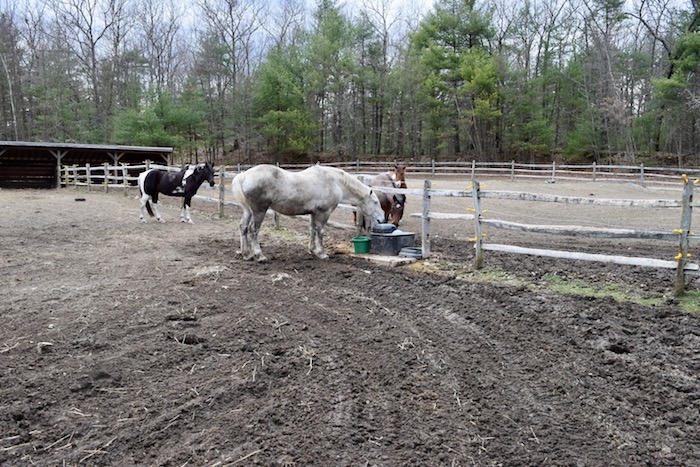
It was not a good situation for Tonka, so I looked at barns with stalls.
Stalls have their benefits. During inclement weather (which we have plenty of in New England), your horse is in a comfortable and safe place that you can easily access. For someone like me who rides daily, a barn with stalls, a secure and dry place for gear, an aisle to groom my horse in, and an indoor ring so that we can stay active, is even better than a shed that one can’t get to in a snowstorm or downpour, or see their way to in the dark of night.
I moved Tonka to this stall. There was a window, and a view of the other horses, daily turnout, and an indoor ring. The stalls were clean, deeply bedded, and the hay was plentiful. But Tonka had to eat his grain with that face looking at him (and often that horse’s rear end as he kicked the wall.)

An easy fix was made by putting up boards so the two didn’t have to look at each other.

After almost two years at that barn, we moved to another so that Tonka could have solo turnout. (Not all horses play well with others.) At this stable, Tonka had a Dutch door. Which he absolutely loved.
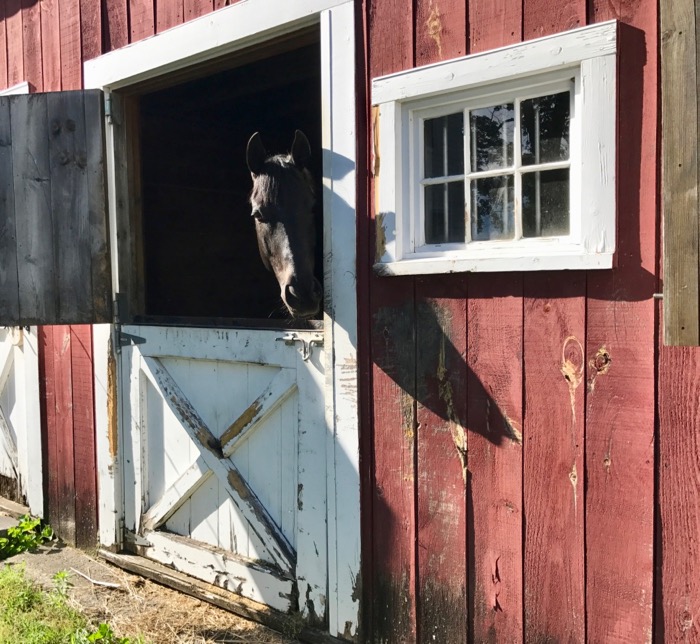
But in the winter, to keep the barn snug and to keep the water from freezing, the door was closed. Tonka still had a window. But he was in the end stall, and could see only one other horse through the front bars. Tonka tolerated the situation.

Then an ideal stall became available at the perfect barn.
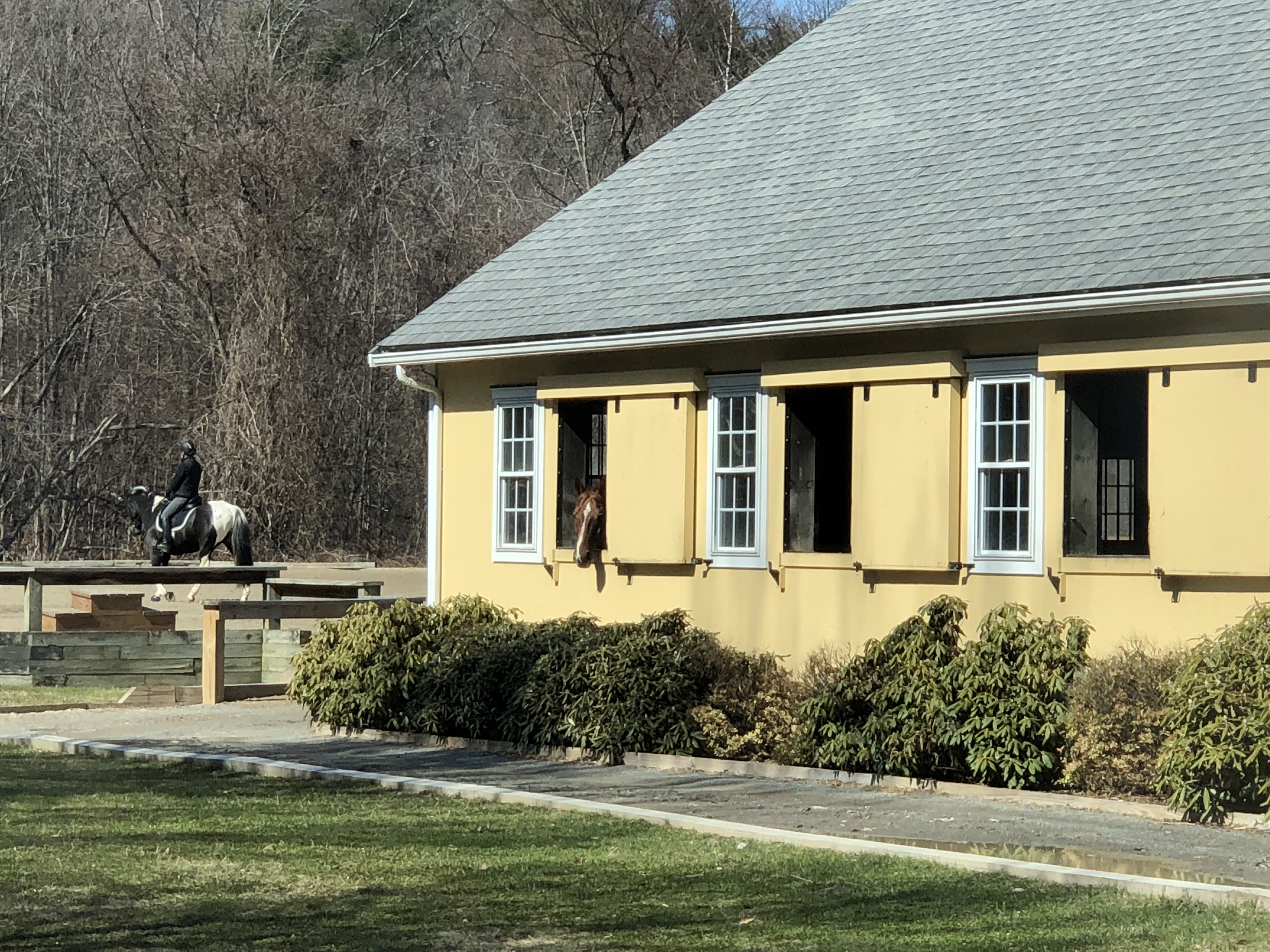
Here, Tonka has huge opening, which is kept open all winter. On the few occasions that it’s slid closed (for howling wind or such) there’s still a large regular window that lets in light and allows Tonka to keep tabs on the goings on outside.

There is also this open half of his stall door, from which he can see and chat with all of the horses and humans inside. Notice how clever the design of the stall doors are, with those shelves. He can look out, but not reach the horses in the aisle. He also can’t toss his blankets about (Tonka has been known to throw things, just for fun.)

Light in this barn abounds. Even when the end doors are closed, windows in them keep the barn bright. At night, well-placed electric lights allow you to see into all corners.
This barn is closing (I’ve talked about that here) AND I’m moving to Maine, so, lately I’ve been looking at a lot of stalls.
Although I’m going only an hour further north, I’m seeing regional differences in the stall design.
I expect to see that on my travels further afield. I recently visited a friend in Houston. Down there, they have to contend with humid heat in the triple digits. What’s important in Texas is shade and ventilation.
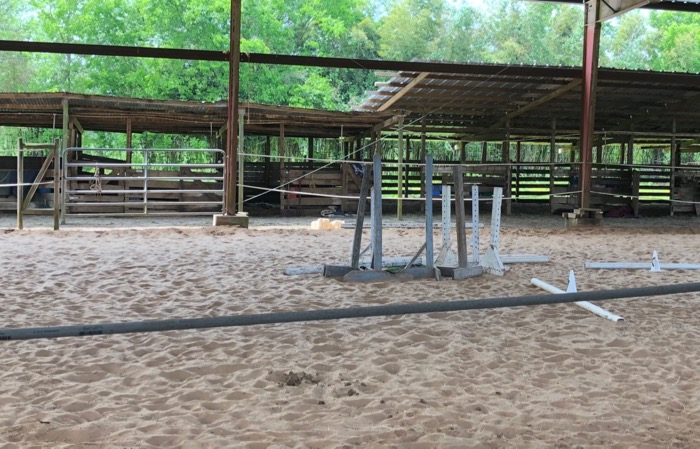
In Maine and New Hampshire, people worry about the opposite: frigid temperatures, biting cold wind and deep snow.
Still, I don’t think that the weather is enough of an excuse to house a horse in a box without windows. There are bars at the front of this stall, but regardless, this seems sad and isolating to me.

I was surprised that even the high-end barns don’t have the sort of windows that I’m used to. I toured a fancy dressage barn, where board is $1,450 monthly. There I saw a block of stalls without any windows. The stalls were walled up so that the horses could only see the patch of aisle in front of them.
I did find barns that had Dutch doors, but none of them also had windows. So, when the door is closed, the stalls are quite dark. In New England in the winter, night falls early in the afternoon. A horse might stand in that gloom for twelve hours, or if a storm is raging, for days.
Finally, I found a compromise at a barn north of where I’ll be moving. Each stall’s interior door has a panel that can be dropped so that a horse can put their head out of the stall and look down the aisle.

Some of the stalls have windows, so natural light does come into the barn. A few of the stalls have Dutch doors. Those stalls don’t have windows, but they do open up to small fenced areas. During the day, all of the horses are turned out in large paddocks, but when they come in at 4 pm, the horses in these stalls can wander in and out at will.
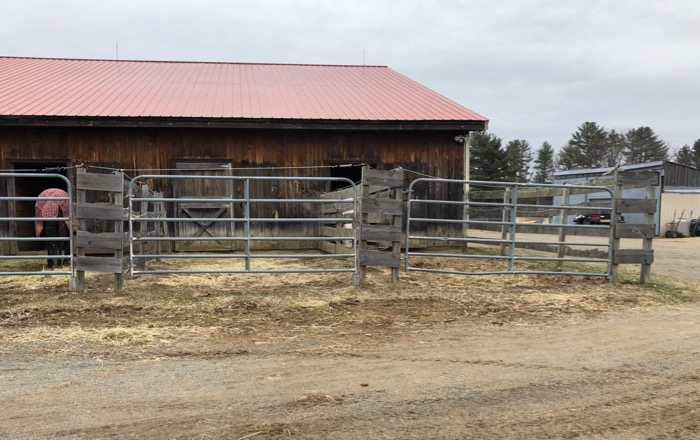
I’ve been told that the doors stay open, even in winter, unless the weather is really awful. So, there’s no window, but the trade-off is an open door and more space to move.
I didn’t know that I’d have to make this compromise over light, windows, and sight lines, when I started looking for Tonka’s new home. But, after visits to fancy dressage barns, a few competitive eventing stables, and even a saddle seat barn, I’ve learned what’s typical in this region, and snugness is valued over windows. Within that context, this barn looks excellent. Other details matter, too. Water buckets are clean. Stalls are mucked out and are bedded with pine shavings.There’s fresh water and hay in the paddocks. The staff are calm.
I’ve lucked out, and the second stall from the end is available. Tonka will be moving sometime at the end of May.
What are stalls in your region like? Tell me in the comments!


When I moved from the mountains of VA to CT, I had the folks who built our barn in VA come build it in CT. “Make it just like the one in VA”, I said. “Are you sure?” they asked? “Even with the tiny opening between the top of the walls and the roof?” “Ventilation is essential to horses”, I replied. That first winter I quickly found out what a mistake that was, but the horses thrived, even if we did not. 🙂
Horrified to hear about that high board up there…crazy! Each region is SO different with their horse keeping traditions! And so much depends on weather, soil type and grass hardiness, etc. With the crazy weather these days, all bets are off. And it’s been very interesting to see in my many years the changes in horse management.
SO glad to hear that you’ve found an acceptable place for Tonka. Hard to leave a barn where you’ve been truly happy for your horse. Gid and I were in one of those for a few years 2000-’04, and loved every day till it changed management. Oh how I’ve missed it!
When you’re tuned into your horse like you are, you hear what they’re saying about their home. I’m sure that Gideon knows you’re listening and doing your best!
Great blog Terry! We need many more conversations like this. Horse owners need to put pressure on boarding establishments to ensure the horse’s basic needs are met. I’ve seen some horrific set ups in very high end barns. Usually to do with isolation and lack of movement. Friends, forage and freedom!
People don’t think about what I see as basic – light and fresh air. I know wonderful people, and otherwise good horse people, who don’t question stalling their horses in the dark for 12 hours a day.
This is a good conversation to have and should be talked about more frequently. Too many horse people do not give enough consideration to how their horses are “living!”
I am fortunate that I have never had to board a horse, but then if I had to board, I wouldn’t have one. For me most of my enjoyment comes from the care of them, and being able to look out the window at them in the pasture at any time. Being able to ride is a bonus!
I have always had my barn area set up so that the horses could come and go at will, facing south, and even though it is considered poor pasture management, all pasture is open and available at all times, allowing for tree cover and plenty of diverse foraging. Here in NH, they love standing and watching people drive, walk or ride down our dirt rd. Those who know them stop and say hi! I truly believe they are quite content!
I’m sure that your horses are quite content 🙂
Here in California I am fortunate to have my horses at home, with a large pasture and run in shed. But a couple weeks ago I traveled to Southern California for lessons with a trainer in my horse sport, gymkhana. This trainer is at a very high end, expensive barn where most of the people pay other people to do every little thing for their horses. I’m so glad it was only for a weekend! My horse’s weekend home was a box stall in a barn, but she could barely see another horse. Deep shavings, but no light. We were very busy with lessons during our short time there so she didn’t spend much time in there, thank goodness. She was so happy to get back home to her pasture with her buddies, and freedom to roam.
I wonder about the ventilation in that barn during the hot SoCal summers…
I believe most boarding barns focus on the convenience of the horse owner and the barn staff, the happiness of the horses is rarely a key factor. And that horse owners need to vote with their feet when conditions are bad.
We have a small farm south of Seattle. Our stalls all have attached 30ft runs as well as half doors into the center aisle. The horses get as much turnout as possible (8-16 hours per day depending on the time of year) and come into the barn at night in the winter and during the day in summer. I tried pasture with shelter and it didn’t work in our climate. Some stall time every day also ensures we can address individual nutrition needs.
I don’t take in boarders that don’t prioritize horse happiness above everything else. I’ve turned down a surprising amount over the years. I’ve had people tell me their horse doesn’t need turnout (!) Or that they don’t want their horse to go out in the rain (hellooo, Seattle!). I feel bad for their horses but try to focus on making our little corner of the world as perfect as possible 🙂
Your place sounds like an isle of happiness.
The boarding barn owners that I know all think that they’re doing right by the horses under their care, which is why discussing changes can be so difficult.
We live in Alberta, Canada. The temperatures here are from -40C to +40C, depending on the season. My horse lives outdoors and has two run in sheds which she shares with her pasture mates. They have a very large tub full of heated water and more hay than can be eaten in a day. There is a barn there and some horses are in stalls for each night (or day as well, when the weather gets bad). My horse has a very warm winter blanket, a medium weight blanket AND a rain sheet. By the time the weather is nice enough to require only the rain sheet I am tired of the whole business and she lives naked. Yes, she is sometimes too dirty to tack up. So I ride her bareback. Or we have a lunge line lesson. She is 19 years old, she and I have been together her whole life, and we are still learning from each other (due in part to amazing people like yourself who share their experiences and knowledge with the rest of us).
You live in an extreme part of the world! I’m impressed with how you’ve been able to give her what she needs, and make compromises that you’re both happy with.